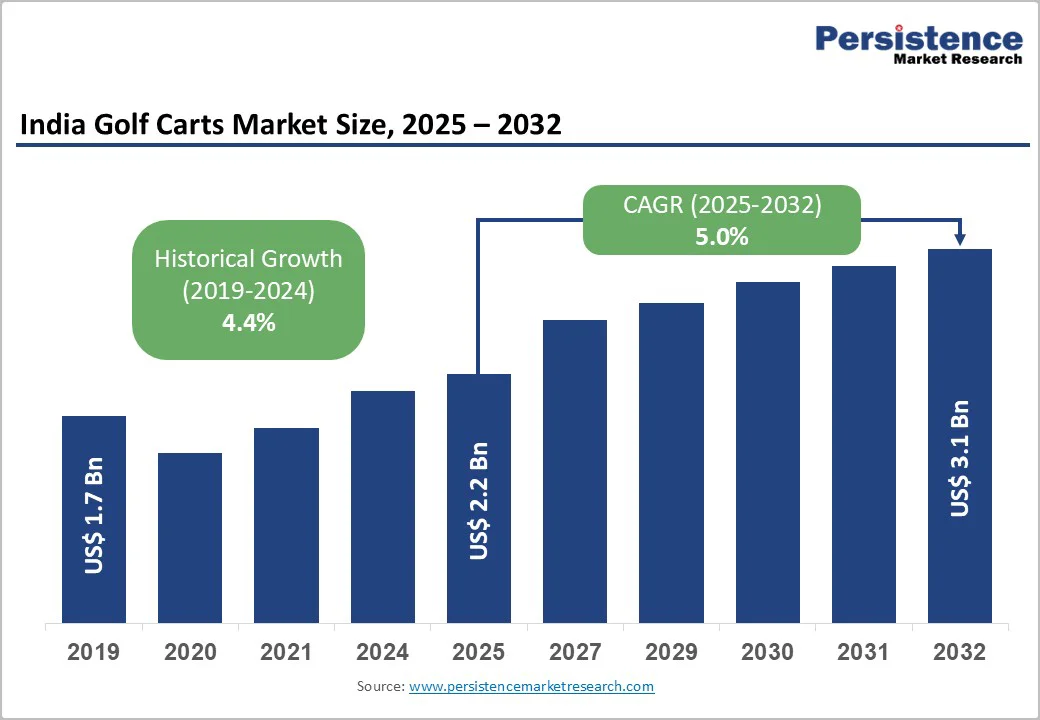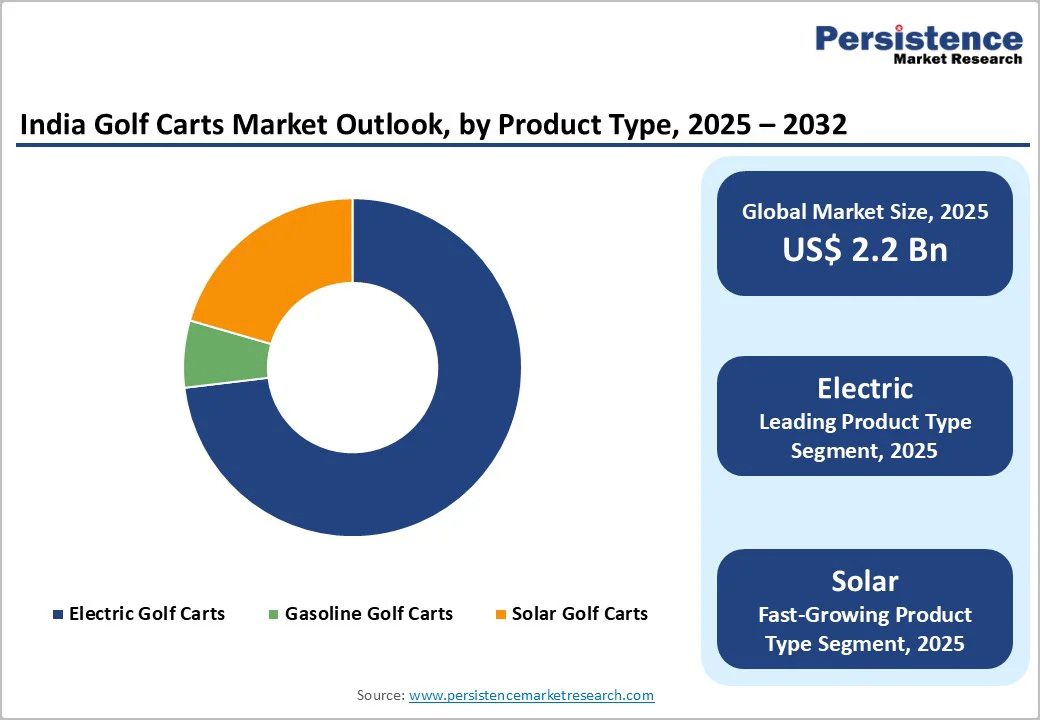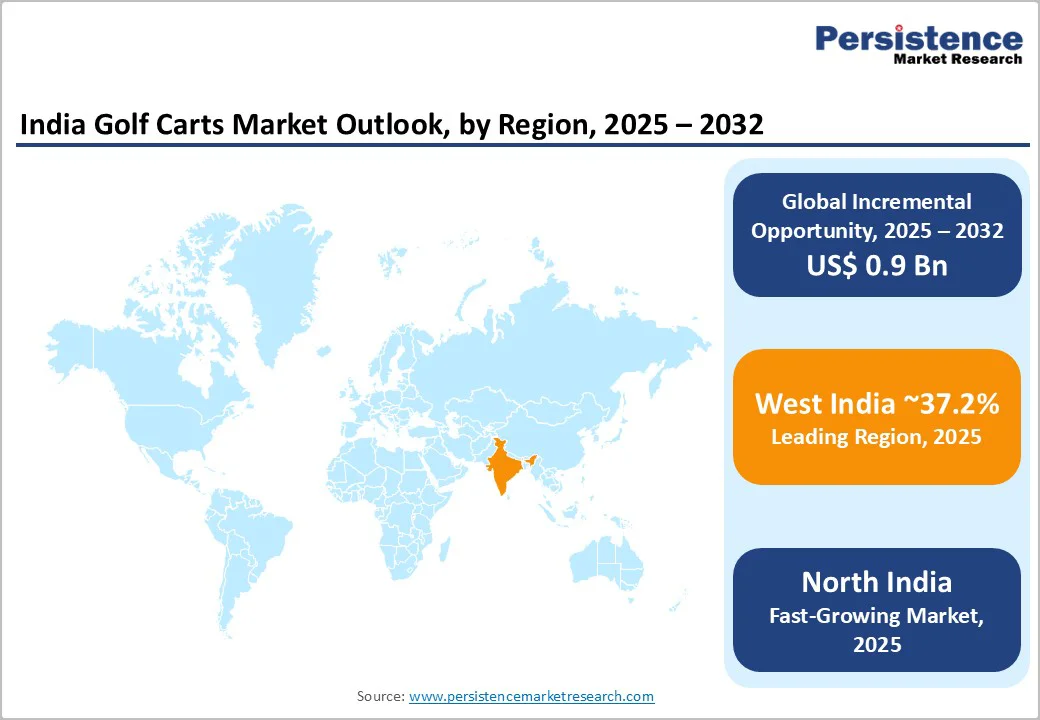ID: PMRREP13447| 185 Pages | 22 Oct 2025 | Format: PDF, Excel, PPT* | Automotive & Transportation

The India golf carts market size is likely to be valued at US$2.2 Billion in 2025 and is estimated to reach US$3.1 Billion in 2032, growing at a CAGR of 5.0% during the forecast period 2025 - 2032, driven by expansion of tourism, hospitality, and luxury real estate, where resorts, hotels, and gated communities increasingly seek convenient and eco-friendly mobility solutions.
| Key Insights | Details |
|---|---|
| India Golf Carts Market Size (2025E) | US$2.2 Bn |
| Market Value Forecast (2032F) | US$3.1 Bn |
| Projected Growth (CAGR 2025 to 2032) | 5.0% |
| Historical Market Growth (CAGR 2019 to 2024) | 4.4% |

The rapid growth of India’s tourism and hospitality sector is a key driver for golf cart adoption. Resorts, hotels, and leisure complexes mainly use golf carts to transport guests efficiently within large properties while improving their experience. For example, luxury resorts in Goa and Kerala have integrated electric carts as shuttle services, allowing guests to move between beaches, villas, and recreational areas quietly and sustainably.
Urban golf courses and private clubs in Maharashtra and Karnataka also rely on multi-seater electric carts to improve operational efficiency and deliver convenience to players. This trend is further fueled by rising domestic and international tourism, as establishments seek to provide premium and eco-friendly mobility options, making golf carts a practical and desirable investment for hospitality operators.
Government initiatives promoting clean energy and electric vehicles are constantly boosting the market in India. Programs such as the FAME II scheme provide subsidies and incentives for electric mobility, reducing the upfront cost of electric golf carts for commercial and institutional users. States such as Maharashtra, Karnataka, and Kerala have introduced additional EV-friendly policies, including registration exemptions, reduced taxes, and infrastructure support for charging stations.
For instance, Maharashtra’s EV policy targets 30% electric vehicle adoption by 2030, which includes commercial electric carts for resorts and campuses. Such supportive regulations make it convenient for hotels, resorts, and gated communities to adopt electric golf carts, accelerating market growth while promoting sustainable and low-emission transport solutions.
One major constraint for golf carts in India is their limited runtime and driving range on a single charge. Most electric carts, commonly used in resorts, golf courses, and gated communities, can operate for only a few hours before requiring recharging. This restricts their usability in large properties or during peak tourist seasons when continuous operation is necessary.
For example, resorts in Goa and Kerala often need to deploy multiple carts to cover the same distance, increasing operational complexity. The lack of widespread fast-charging infrastructure in various cities further exacerbates this limitation, making it challenging for operators to rely solely on electric carts for extended or high-intensity applications, thereby slowing adoption beyond premium and small-scale use cases.
Golf carts require regular maintenance of tires, wheels, batteries, and mechanical components to ensure smooth and safe operation. The upkeep of these parts can be costly, especially for commercial users managing large fleets in resorts, golf courses, or institutional campuses. In India, service networks for specialized components are still limited outside key cities, which adds to downtime and repair costs.
For instance, luxury carts such as the Kinetic Green-Tonino Lamborghini series require periodic servicing and battery replacement, which can be expensive for small operators. High maintenance expenses act as a barrier for widespread adoption, keeping electric golf carts mainly within high-end hospitality and premium residential segments.
Golf carts in India are increasingly finding use beyond traditional golf courses, opening new growth opportunities. Airports, amusement parks, large event venues, and industrial campuses are adopting electric carts for efficient internal transport of passengers, staff, and luggage. For example, the Indira Gandhi International Airport in Delhi has trialed electric carts to shuttle passengers between terminals and parking areas, reducing congestion and emissions.
Also, amusement parks in Maharashtra and Tamil Nadu are deploying multi-seater carts to improve visitor experience and operational efficiency. This diversification into non-golf sectors allows manufacturers to broaden their customer base, increase fleet sales, and promote electric mobility solutions in areas where conventional vehicles are less practical or sustainable.
The incorporation of smart connectivity features in golf carts is creating new avenues in India. Modern models now include GPS tracking, digital dashboards, battery monitoring systems, and mobile app-based fleet management tools. Resorts, campuses, and commercial operators can monitor location, performance, and usage patterns remotely, improving efficiency and reducing downtime.
For instance, Saera Electric Auto in Delhi delivers carts with integrated GPS and telematics systems, enabling real-time monitoring and predictive maintenance. The trend toward connected and data-driven operations allows operators to optimize fleet utilization, reduce operational costs, and improve customer experience. It further makes technologically advanced golf carts an attractive investment for both private and institutional buyers.
Electric golf carts are predicted to hold approximately 73.1% of the share in 2025 owing to their quiet operation, low maintenance, and eco-friendly nature. They are ideal for resorts, golf courses, and gated communities where reducing noise and emissions is important for guest experience and environmental compliance. For instance, luxury resorts in Goa and Kerala use six- and eight-seater electric carts to transport guests efficiently across large properties without polluting the environment.
Solar-powered golf carts are gaining popularity because they provide an environmentally sustainable alternative while reducing dependency on grid electricity. By integrating solar panels on roofs, these carts can extend their operational range and decrease charging frequency. It is specifically valuable in sunny states such as Rajasthan and Karnataka. Resorts and eco-friendly tourist destinations are adopting solar carts to showcase sustainability initiatives.
Small (2 to 4 seater) golf carts are speculated to account for around 46.8% of the share in 2025, boosted by their maneuverability, affordability, and suitability for narrow pathways in resorts, gated communities, and urban campuses. Their compact size allows easy navigation through tight spaces while still providing convenient transport for a few passengers. For example, boutique resorts in India often deploy two- to four-seater electric carts for short-distance guest movement between rooms, dining areas, and recreational zones.
Medium (6 to 8 seater) golf carts are seeing considerable demand due to their ability to transport large groups efficiently, which is valuable in resorts, airports, amusement parks, and large golf courses. They provide high seating capacity without requiring significantly more space or operational complexity. For instance, resorts in Rajasthan and Karnataka use six- and eight-seater electric carts to shuttle multiple guests simultaneously, improving operational efficiency and guest experience.
Golf courses remain the primary application for golf carts with a share of nearly 55.4% in 2025, as they require efficient and quiet transportation across vast greens without disrupting play. Carts enable players to move between trees, fairways, and clubhouses quickly, improving both convenience and course management. The need for low-emission, reliable, and comfortable mobility in sprawling golf landscapes makes courses the central hub for cart usage.
Golf carts are increasingly used for personal services in luxury resorts, gated communities, and large residential complexes to improve convenience and guest experience. They help shuttle residents or visitors between amenities such as clubhouses, gardens, parking lots, and recreational areas. This trend highlights the surging role of golf carts as lifestyle and service-enhancing vehicles beyond traditional golfing purposes.

In 2025, West India is estimated to account for around 37.2% of the share, with growth rising in Maharashtra, Goa, and Gujarat. These states have a high concentration of luxury resorts, golf clubs, and gated communities that use electric carts for guest transport and internal mobility. Goa’s tourism-driven infrastructure has made golf carts a common sight in premium resorts such as The LaLiT and Taj Exotica, where they are used to move guests between villas, beaches, and restaurants.
Pune and Mumbai also see rising usage in private townships and golf courses such as Oxford Golf Resort, which uses multi-seater carts for players and visitors. Government support has made West India a favorable region for electric golf cart adoption. Maharashtra’s EV policy targets 30% electric vehicle penetration by 2030 and provides benefits such as subsidies, road tax exemptions, and reduced registration fees for EVs, including golf carts. These incentives are encouraging hotels, institutions, and gated communities to invest in sustainable mobility solutions.
Golf carts in North India are extensively used in tourism, public spaces, and gated communities. Delhi NCR, Prayagraj, and Bhopal have deployed electric carts to improve mobility while reducing noise and pollution. For example, Van Vihar National Park in Bhopal replaced private vehicles with 40 six-seater golf carts for visitors, and Prayagraj introduced eight-seater carts to help pilgrims move comfortably between religious sites. These deployments highlight the rising preference for eco-friendly and efficient transport solutions in public and recreational areas.
Local manufacturing is expanding to meet this demand. Companies such as Saera Electric Auto in Delhi produce six-seater electric carts with all-terrain tires, LED lights, and an 80 km range. Other suppliers, including Edgo Carts in Punjab and AK Autto Electrical in Delhi, provide models ranging from two to eight seats for institutional, resort, and event use. Premium and customized options are also available to cater to tourism, hospitality, and luxury residential sectors.
In South India, golf carts are increasingly utilized for tourism, resort transportation, and eco-friendly mobility solutions. Companies such as Tri Electric in Tamil Nadu manufacture electric golf carts and sightseeing buses, catering to resorts, educational institutions, and industrial campuses. In Kerala, Eddy Lovebird specializes in custom-built electric buggies for resorts and hotels, emphasizing high performance and design.
Beeydees India Industries Pvt. Ltd. also provides a range of electric golf carts for rent in cities such as Bengaluru and Visakhapatnam, serving purposes, including event logistics, resort shuttles, and campus mobility. The adoption of golf carts is further supported by government initiatives. For instance, Kerala Automobiles Ltd. (KAL) has developed the Electric Buggy 1.0, a five-seater vehicle designed for campus and institutional use, showcasing the state's commitment to sustainable transportation solutions.

The India golf carts market is seeing constant change, led by electrification, partnerships between luxury and local brands, rising demand from resorts/residential, and a regulatory push toward EVs. Key companies are setting up plants near ports or in Special Economic Zones (SEZs) to streamline export logistics. For example, the Kinetic-Lamborghini JV produces carts near Pune and uses Nhava Sheva port for export operations.
Beyond making carts, leading companies in the India golf carts market are investing in battery and charging or swapping infrastructure to strengthen their presence. For instance, Kinetic Green proposes a battery-swapping unit to support its carts and other EVs in Andhra Pradesh. A few other firms are striving to comply with India’s EV policies, such as PM E-DRIVE and subsidy scheme, to get benefits on e-carts. Kinetic’s moves are timed to take advantage of supportive incentive regimes.
The India golf carts market is projected to reach US$2.2 Billion in 2025.
Rapid growth in tourism and government support for electric mobility are the key market drivers.
The India golf carts market is poised to witness a CAGR of 5.0% from 2025 to 2032.
Increasing demand from large residential complexes and integration of GPS tracking are the key market opportunities.
Club Car, LLC, Yamaha Golf-Car Company, and Speedways Electric are a few key market players.
| Report Attribute | Details |
|---|---|
| Historical Data/Actuals | 2019 - 2024 |
| Forecast Period | 2025 - 2032 |
| Market Analysis | Value: US$ Bn |
| Geographical Coverage |
|
| Segmental Coverage |
|
| Competitive Analysis |
|
| Report Highlights |
|
By Product Type
By Seating Capacity
By Application
By Region
Delivery Timelines
For more information on this report and its delivery timelines please get in touch with our sales team.
About Author